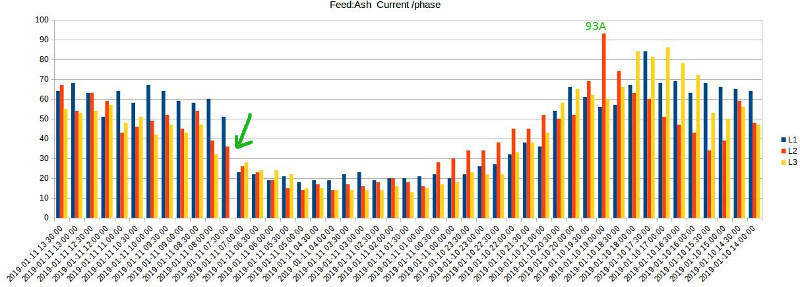- Forum
- Green tech & greener living
- Home and heating
- New batteries being installed - is it worth going to eco 7 to charge them overnight?
New batteries being installed - is it worth going to eco 7 to charge them overnight?
- January 9, 2019
- 19 replies
- 7019 views
- Carbon Cutter****
I am having batteries installed on the 19th Jan and my question is, is it worth going to eco7 to charge them overnight in the winter so I get next day at cheap rate until proper time of use tariffs become available?
Best answer by Transparent
Updated on 16/05/25 by Chris_OVO
Great to hear about your new Home Energy Storage!
As you’ve mentioned an Economy 7 tariff could be the perfect partner to this new kit. It will depend on certain factors such as the breakdown of your usage and the capacity of your battery. Check out the thread below for our community members take on the benefits of a dual-rate plan.
As we no longer offer a traditional meter replacement, in order to change to an Economy 7 plan, you’ll need to get a smart meter installed.
When they are first installed the smart meter will match the function of your previous meter (i.e. a single rate traditional meter will be replaced by a single rate Smart Meter). This function may be updated after the meter is installed but this will depend on the communication of the meter and other technical limitations. If you’d like to discuss the option of updating the function of your smart meter to an dual rate, reach out to our Support Team who can advise whether it’s possible on your account.
If an update to your meter is possible your plan will be updated to match the Economy 7 rates available when your current fixed plan started or the current Economy 7 variable rates, if you’re on the Simpler Energy plan. Our Support Team will confirm these rates before updating your plan.
There’s other great benefits to getting a smart meter installed - read more about this here!
Whatever you decide works best for you, we’re keen to hear more about your Home Energy Storage set-up.
OVO member but not got a smart meter yet? - Book today!
Interested but not yet an OVO member? - Check out our plans!
19 replies
- Carbon Catcher***
- January 9, 2019
Welcome to the forum and Congratulations having batteries installed in your home. This is a very good question and I believe
- Carbon Catcher***
- Solved
- January 10, 2019
Updated on 16/05/25 by Chris_OVO
Great to hear about your new Home Energy Storage!
As you’ve mentioned an Economy 7 tariff could be the perfect partner to this new kit. It will depend on certain factors such as the breakdown of your usage and the capacity of your battery. Check out the thread below for our community members take on the benefits of a dual-rate plan.
As we no longer offer a traditional meter replacement, in order to change to an Economy 7 plan, you’ll need to get a smart meter installed.
When they are first installed the smart meter will match the function of your previous meter (i.e. a single rate traditional meter will be replaced by a single rate Smart Meter). This function may be updated after the meter is installed but this will depend on the communication of the meter and other technical limitations. If you’d like to discuss the option of updating the function of your smart meter to an dual rate, reach out to our Support Team who can advise whether it’s possible on your account.
If an update to your meter is possible your plan will be updated to match the Economy 7 rates available when your current fixed plan started or the current Economy 7 variable rates, if you’re on the Simpler Energy plan. Our Support Team will confirm these rates before updating your plan.
There’s other great benefits to getting a smart meter installed - read more about this here!
Whatever you decide works best for you, we’re keen to hear more about your Home Energy Storage set-up.
OVO member but not got a smart meter yet? - Book today!
Interested but not yet an OVO member? - Check out our plans!
- Author
- Carbon Cutter****
- January 10, 2019
Regards to all Pete.
- OVO Product Team
- January 11, 2019
When you say 'proper time of use' tariff
If, as
Really look forward to hearing more on this.. anyone else reading this with an interest in time-of-use tariffs, we would love to hear from you too!
- Author
- Carbon Cutter****
- January 11, 2019
So as you can see you are charged depending on what time you use your electricity, no good for normal users but if you have batteries or an e.v. you can charge up at the low overnight rate for use during the day. If your batts run out during the day so long as it's not during the peak period you won't be charged at much more than standard rate. The idea behind it all is to use people's batteries to smooth out the peaks and throughs in the supply meaning they won't need so many generating stations and means that I get all/most of my electricity during the day at low overnight prices so I will benefit and the grid benefits as well.
Hope this all makes sense to you.
Regards to all Pete.
- Carbon Catcher***
- January 13, 2019
I guess most electricity consumers don't yet realise the parameters which might be taken into account when TOU Tariffs are being set.
Most, like
I don't see it like this. Since we're on the open Forum, let me put forward two scenarios which show alternative reasons why the cost per kWh might vary:
A. I live in a rural region that has a surplus of renewable energy. There is insufficient capacity in the Transmission Grid (above 32kV) to send this surplus back up the line to cities that are in energy deficit.
So on sunny or windy days, the cheaper rates are more likely to be available to me in the middle of the day rather than at night.
If I have a Storage-Battery or an EV connected to my charger, I might configure these to
- take in electricity when the cost per unit falls below 10p, or
- take in electricity when it is at least 5p /unit lower than the evening peak
B. Electricity DNOs are financially incentivised to minimise losses in the Distribution Grid (32kV and below). Currently this RIIO-ED1 strategy is having little effect.
Technical Losses (ie excluding theft!) have increased from around 5% to 10% over the last 20 years, not helped by numerous customers adding solar-panels to their single-phase domestic supplies!
The graph here shows the current being drawn by the three-phases (L1, L2 & L3) on a Feed named "Ash" at a sub-station about 2Km from where I'm based.
When there is a current imbalance between phases, the efficiency of the substation transformer falls. This energy-loss causes a corresponding rise in the core temperature.
It is quite possible that a DNO might wish to meet their RIIO-ED1 targets by reducing the phase-imbalance. In short, I could instruct my Storage Battery to "Track Δ-Phase of my sub-station" and be rewarded with a financial bonus for reducing the losses.
Now I'm not suggesting that customers should in any way need to get involved with the technicalities of how the price-per-HH timeslot is actually calculated.
The reason I have access to this substation data is so we can test what sort of incentives are likely to result in consumers changing their energy usage. The actual user-interface may be extremely simple.
(Aside: The above graph is in reverse time notation. As it's a snapshot of a "live" data-feed, new readings are being added to the left side of the x-axis.
These are average figures per HH per phase. The 93A average on L2 around 7pm on Saturday evening was actually a peak of 139A coinciding with the start of Michael McIntyre's Big Show on BBC1 and Top Gear Highlights on BBC2.
I can provide further explanations if requested!)
- OVO Product Team
- January 14, 2019
Thanks for this - my main question back to you
Thanks,
Hari
- Carbon Catcher***
- January 14, 2019
I mentioned only Battery Storage because that's the Topic title which
I see four main reservoirs of energy in homes:
- Storage Battery
- EV with V2G charger
- Thermal-store or Hot-water cylinder (using immersion heater)
- Electric Storage Radiator
Some homes will also be micro-generators. Most commonly these will have PV-panels (single-phase 4Kw max). However, a few may have a wind- or water-turbine etc.
I also discriminate between two different categories of imbalance which is wasting energy in the UK:
- Phase imbalance causing losses in the Distribution Network (32kV & below)
- Surfeit of renewable generation in a geographical region
If there is need to balance the distribution grid in an area, VCharge could dump excess generation into the energy reservoirs of that region based on the parameters set up by the customers.
Some customers may have only storage radiators (connected via ALCS to their SMETS2 meter). Typically these might be elderly people or historic houses. In either case it doesn't matter how/when the radiator is supplied with power, so long as the building meets a preset temperature profile.
Vcharge may in fact elect to dump energy into a local network of OVO's customers on the PSR who have storage radiators by taking it from neighbouring houses with PV arrays and hence avoid having to pay for any transportation across the Transmission Grid!
Equally, if there is a regional/local energy deficit (eg the evening peak), then Vcharge can call on the available Storage Batteries and EV's according to their preset parameters.
An EV owner with V2G may, for example, set up preferences on their IHD to set up the following rules:
* You may access 70% of my vehicle's stored energy between 6-10pm. This leaves me 30% if I need to pop out during the evening.
* You must credit me at least 1.6p /unit more than I paid to charge my EV
* You must recharge my EV between 10pm-6am to a minimum 50% so that I have enough energy to drive to work.
Interestingly, many of the constituent parts of this 21st century smart-grid are in the hands of the OVO Group! However, we have as yet seen little sign of these being promoted into the innovative roles that I've outlined above.
I think OVO needs to migrate from seeing itself as a Domestic Energy Supplier and mutate into being a Domestic Energy Facilitator. This requires a bolder, more adventurous path to widen the income-stream beyond a defined set of customers with an account!
This will include offering VCharge's distributed network management system to Community-run Microgrids, particularly on new-build estates where every house will have SMETS2 meters and EV Chargers.
The Community Group pays for access to VCharge, whether or not individual customers are signed up to OVO. However, OVO may elect to receive that payment in kind, as renewable-energy exported from the Microgrid which it needs to satisfy its growing demand from customers signed up to a Green Energy Tariff.
... and once again,
- Carbon Catcher***
- January 15, 2019
Let's imagine they have a SMETS2 meter, and have connected their washing machine (or dishwasher) using one of the available ALCS channels. These are both examples of domestic appliances which can be loaded and then left "ready to run" when energy is cheaper.
So if they are on a HH variable tariff, a typical set-up might be
* Run when the price /kWh falls to 3p lower than the average over the last 24hours
* If the next HH period is at a higher rate, then continue anyway (we don't want a wash-cycle stopped part-way!)
* If the first parameter hasn't been reached by 6am then run anyway (so I can unload before going to work in the morning).
On a sunny/windy day here in the Westcountry, I'd expect most washing machines to run immediately. In a major city, they may run overnight, in similar fashion to the current E7 tariff.
Now again, let me emphasise, I'm not suggesting that the customer has to enter these instruction sets freehand. The user-interface on the IHD (or Smartphone App) may be extremely simple. All I'm doing here is to show a set of parameters which might be reasonable and will save energy.
One of the things we're testing here with our Smart sub-station is an App which allows us to survey how consumers respond to financial incentives when using energy. Which is most likely to change their habits?... an on-screen message which says
- you can save 2p per kWh by delaying your washing machine
- you can save 7p on the next load of washing
- you can save £13.24 a year if you change to delayed wash-cycles
- OVO Product Team
- January 16, 2019
You've got some really great ideas and I think one thing we are certainly agreed on is that the end consumer should be able to optimise their device behaviour with minimal complexity, through intuitive user interfaces!
As a start point, I don't think our VCharge platform is a million miles off getting to some of the things you have outlined. For example, if you have a V2G Charger, with the accompanying app you will be able to tell us the minimum charge level you want in your Nissan LEAF at any time, then based on network signals we will:
- Charge your car when demand on the grid is low
- Export power to the grid when it needs it most
I appreciate this is probably only the tip of the iceberg (and I really like the idea of being able to make money from pausing my washing machine and dishwasher!) - but we're regularly looking to understand how we can bring flexibility to more people, as I said above, with minimal complexity and in an intuitive manner. With our V2G Charger, and our Smart Charger - we're just at the beginning!
Exciting times...
Hari
- Carbon Catcher***
- January 21, 2019
I read today that your rivals, Octopus, have come top in the Which? annual survey of Energy Companies, which can be viewed here.
Now, their sample-size is small, but it's interesting that the company who have committed most in the UK to a variable half-hour tariff system is also rated highest by its customers. This should serve to spur on OVO to take a bolder, more adventurous step in this direction. Home Storage with batteries isn't going to progress until it has a relevant tariff structure behind it.
And, by the way, if you look at the larger table of the Which? survey here, you'll notice that OVO came 2nd overall when you add the Customer Service score to the stats for Call Waiting and Complaints Handling!
- Author
- Carbon Cutter****
- January 27, 2019
Sorry for suddenly going quiet but have been busy monitoring my batteries to see how they perform before taking the plunge.
What I have found is that on a full 100% charge overnight the battery (winter time) will last up until around 10.30pm before running out. So if I charged at eco7 overnight the battery would cover most of the day, but when heavy use is made I.e. tumble dryer (no timer on it) the battery will only last until maybe 3.00pm before running out. This would mean paying a higher rate for the rest of the day.
I can mitigate this to a certain extent by only using the washing machine overnight.
Now the decision I have to make is overall would I still see savings even though at some times I will be paying a higher rate for my electricity and I think that the answer is yes but it will be reduced by my tumble dryer having to be used during the day.
The other use (and the main reason for the batteries) is that I have 4KWp of solar PV on an east facing roof. This means that during the summer I lose generation around 3.30pm, my idea is to have the PV supply all my power needs during the day till 3.30 and charge my batteries so that they will take the load from then on to even out my solar generation, this means that during the summer months having eco 7 would not matter as should not use any higher rate electricity.
So I think that yes eco7 should see worthwhile savings over the year.
Rregards to all Pete.
- Carbon Catcher***
- January 27, 2019
The present tariff structures aren't in your favour yet.
However, have a look at what I posted here on another Topic a couple of days ago.
Note the bit about RIIO-ED2 and your DNO having the ability to set their own individual rates (the network part of your charges) for each house.
If you live in an area where there is a significant early-evening peak demand period, then you may find that you are best off by reselling some of your stored energy back to the grid when the DNO requires it.
These concepts are not yet implemented in domestic tariffs. But we've reached a moment when there are about to be major changes in the way we buy/sell energy in the UK. You are heading in precisely the right direction.
- Author
- Carbon Cutter****
- January 28, 2019
Yes very interesting times, and I have started hearing about the buy back of electricity if you have batteries, would definitely be interested in these schemes when they get going. Monitoring the batteries you are right, I have already worked out that for winter use I may have to add another 2.4KWh battery as current 7.2KWh stack is struggling to cope and what I don't want is a future scenario of being on ToU tariff and my battery gives up during the early evening while using the cooker in the most expensive time period, my battery needs to be able to take me through to at least 8.00pm.
Rregards to all Pete
- Carbon Catcher***
- January 29, 2019
Once we get true Time-Of-Use tariff structures operating in the energy market, it's quite possible that your DNO will be seeking to store excess solar generation locally. You may get slots of cheap-power offered in the middle of the day so that the DNO doesn't have to send it back into the Transmission Grid (above 32kV).
It's possible that you will actually earn more from storage batteries if their available capacity can be utilised several times each day. It's simply too early to predict this yet.
- Author
- Carbon Cutter****
- January 29, 2019
Yes and where I am would be a brilliant area to trial it as have a large offshore wind farm and a huge solar farm both feeding into my towns 11kv substation, so chances are we nearly always have renewable power feeding the town.
Just seems that the DNO's are being a bit slow off the mark with domestic battery use, maybe not enough out there yet but I think that that's about to change as domestic batteries are now down to an affordable price at last, only reason i have taken the plunge. (Beware of electricians who are buying batteries at wholesale price then doubling the price to you for installation, they are conning you)
Rregards to all Pete
- Author
- Carbon Cutter****
- February 14, 2019
Ok I have so far found that the reason for my batteries running out early was caused by the inverter was set to charge them to 80% then stop😔 so batteries now lasting all day unless heavy use made of the dryer etc.
From today I am now on E7 tariff, so now to see how they perform charging overnight on E7. I will let you know.
Regards to all Pete.
- Retired Moderator
- February 26, 2019
- Author
- Carbon Cutter****
- February 26, 2019
Ok Batteries have been fine during the nice weather we have had, been charging them on E7 overnight but then they have been re-charged by my solar panels during the morning if needed and the panels power the house during the morning and early afternoon.
After the sun goes over the yardarm (Well my roof anyway, unfortunately I am east/west orientated) the batteries take on the load and last through to 12.30 E7 time.
When there is no sun, a rainy or overcast day they are not so good. On an E7 overnight charge they last until around 10.30pm on average but I still think that overall I will be saving on my bill.
So far I am more than impressed with them, the system is working brilliantly for me and exceeding my expectations.
RRegards to all Pete.
Need advice from other members?
Ask your question to our members - they have the experience you're looking for:
Ask our communityLog in to the OVO Forum
No account yet? Create an account
Enter your E-mail address. We'll send you an e-mail with instructions to reset your password.
Scanning file for viruses.
Sorry, we're still checking this file's contents to make sure it's safe to download. Please try again in a few minutes.
OKThis file cannot be downloaded
Sorry, our virus scanner detected that this file isn't safe to download.
OK









